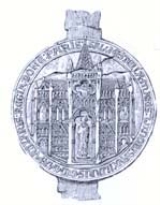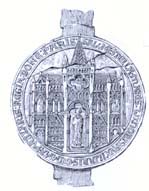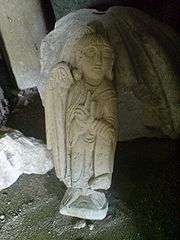
Shaftesbury Abbey
Encyclopedia

Nun
A nun is a woman who has taken vows committing her to live a spiritual life. She may be an ascetic who voluntarily chooses to leave mainstream society and live her life in prayer and contemplation in a monastery or convent...
s in Shaftesbury
Shaftesbury
Shaftesbury is a town in Dorset, England, situated on the A30 road near the Wiltshire border 20 miles west of Salisbury. The town is built 718 feet above sea level on the side of a chalk and greensand hill, which is part of Cranborne Chase, the only significant hilltop settlement in Dorset...
, Dorset
Dorset
Dorset , is a county in South West England on the English Channel coast. The county town is Dorchester which is situated in the south. The Hampshire towns of Bournemouth and Christchurch joined the county with the reorganisation of local government in 1974...
. Founded in the year 888, the abbey was the wealthiest Benedictine
Benedictine
Benedictine refers to the spirituality and consecrated life in accordance with the Rule of St Benedict, written by Benedict of Nursia in the sixth century for the cenobitic communities he founded in central Italy. The most notable of these is Monte Cassino, the first monastery founded by Benedict...
nunnery in England, a major pilgrimage site, and the town's central focus. The abbey was destroyed
Dissolution of the Monasteries
The Dissolution of the Monasteries, sometimes referred to as the Suppression of the Monasteries, was the set of administrative and legal processes between 1536 and 1541 by which Henry VIII disbanded monasteries, priories, convents and friaries in England, Wales and Ireland; appropriated their...
in 1539 by the order of Thomas Cromwell.
Early history

Alfred the Great
Alfred the Great was King of Wessex from 871 to 899.Alfred is noted for his defence of the Anglo-Saxon kingdoms of southern England against the Vikings, becoming the only English monarch still to be accorded the epithet "the Great". Alfred was the first King of the West Saxons to style himself...
and his daughter Æthelgifu founded the Abbey in 888 (8 years after founding the town of Shaftesbury as a burgh
Burgh
A burgh was an autonomous corporate entity in Scotland and Northern England, usually a town. This type of administrative division existed from the 12th century, when King David I created the first royal burghs. Burgh status was broadly analogous to borough status, found in the rest of the United...
), which boosted the town's growth. The relics of St Edward the Martyr
Edward the Martyr
Edward the Martyr was king of the English from 975 until he was murdered in 978. Edward was the eldest son of King Edgar, but not his father's acknowledged heir...
were translated from Wareham and received at the abbey with great ceremony. The translation
Translation (relics)
In Christianity, the translation of relics is the removal of holy objects from one locality to another ; usually only the movement of the remains of the saint's body would be treated so formally, with secondary relics such as items of clothing treated with less ceremony...
of the relics was overseen by St Dunstan
Dunstan
Dunstan was an Abbot of Glastonbury Abbey, a Bishop of Worcester, a Bishop of London, and an Archbishop of Canterbury, later canonised as a saint. His work restored monastic life in England and reformed the English Church...
and Earl Ælfhere of Mercia. This occurred in a great procession
Procession
A procession is an organized body of people advancing in a formal or ceremonial manner.-Procession elements:...
on February 13, 981 and arrived at Shaftesbury seven days later. There the relics were received by the nun
Nun
A nun is a woman who has taken vows committing her to live a spiritual life. She may be an ascetic who voluntarily chooses to leave mainstream society and live her life in prayer and contemplation in a monastery or convent...
s of the abbey and were buried with full royal honours on the north side of the altar
Altar
An altar is any structure upon which offerings such as sacrifices are made for religious purposes. Altars are usually found at shrines, and they can be located in temples, churches and other places of worship...
. On the way from Wareham to Shaftesbury, a miracle had taken place; two crippled men were brought close to the bier and those carrying it lowered the body to their level, whereupon the cripples were immediately restored to full health. This procession and these events were re-enacted 1000 years later in 1981. Many other miracles are said to have been obtained through Edward's intercession.
In 1001, it was recorded that the tomb in which St Edward lay was observed regularly to rise from the ground. King Æthelred
Ethelred the Unready
Æthelred the Unready, or Æthelred II , was king of England . He was son of King Edgar and Queen Ælfthryth. Æthelred was only about 10 when his half-brother Edward was murdered...
instructed the bishops to raise his brother's tomb from the ground and place it into a more fitting place. The bishops then took away the relics from the tomb, and placed them in a casket in the holy place of the saints together with other holy relics. This elevation of the relics of Edward took place on 20 June 1001.
Shaftesbury abbey was rededicated to the Mother of God and St Edward. The town itself was then apparently renamed "Edwardstowe", only reverting to its original name after the Reformation
English Reformation
The English Reformation was the series of events in 16th-century England by which the Church of England broke away from the authority of the Pope and the Roman Catholic Church....
. Many miracles were recorded at the tomb of St Edward, including the healing of lepers and the blind. The abbey became the wealthiest Benedictine
Benedictine
Benedictine refers to the spirituality and consecrated life in accordance with the Rule of St Benedict, written by Benedict of Nursia in the sixth century for the cenobitic communities he founded in central Italy. The most notable of these is Monte Cassino, the first monastery founded by Benedict...
nunnery in England, a major pilgrimage site and the town's central focus.
In 1240 Cardinal Otto Candidus, legate
Papal legate
A papal legate – from the Latin, authentic Roman title Legatus – is a personal representative of the pope to foreign nations, or to some part of the Catholic Church. He is empowered on matters of Catholic Faith and for the settlement of ecclesiastical matters....
to the Apostolic See
Apostolic See
In Christianity, an apostolic see is any episcopal see whose foundation is attributed to one or more of the apostles of Jesus.Out of the many such sees, five acquired special importance in Chalcedonian Christianity and became classified as the Pentarchy in Eastern Orthodox Christianity...
of Pope Gregory IX
Pope Gregory IX
Pope Gregory IX, born Ugolino di Conti, was pope from March 19, 1227 to August 22, 1241.The successor of Pope Honorius III , he fully inherited the traditions of Pope Gregory VII and of his uncle Pope Innocent III , and zealously continued their policy of Papal supremacy.-Early life:Ugolino was...
, visited the abbey and confirmed a charter of 1191, the first entered in the Glastonbury
Glastonbury Abbey
Glastonbury Abbey was a monastery in Glastonbury, Somerset, England. The ruins are now a grade I listed building, and a Scheduled Ancient Monument and are open as a visitor attraction....
chartulary
Chartulary
A cartulary or chartulary , also called Pancarta and Codex Diplomaticus, is a medieval manuscript volume or roll containing transcriptions of original documents relating to the foundation, privileges, and legal rights of ecclesiastical establishments, municipal corporations, industrial...
. By 1340, the steward of the abbess swore in the town's mayor
Mayor
In many countries, a Mayor is the highest ranking officer in the municipal government of a town or a large urban city....
.
Destruction
It was said at the time of the Dissolution of the MonasteriesDissolution of the Monasteries
The Dissolution of the Monasteries, sometimes referred to as the Suppression of the Monasteries, was the set of administrative and legal processes between 1536 and 1541 by which Henry VIII disbanded monasteries, priories, convents and friaries in England, Wales and Ireland; appropriated their...
that "if the abbess of Shaftesbury and the abbot of Glastonbury Abbey
Glastonbury Abbey
Glastonbury Abbey was a monastery in Glastonbury, Somerset, England. The ruins are now a grade I listed building, and a Scheduled Ancient Monument and are open as a visitor attraction....
had been able to wed, their son would have been richer than the King of England" such were the lands that it had been bequeathed. It was too rich a prize for Thomas Cromwell to pass up. In 1539, the last abbess, Elizabeth Zouche, signed a deed of surrender, the abbey was demolished, and its lands sold, leading to a temporary decline in the town. Sir Thomas Arundell, 1st Baron Arundell of Wardour
Thomas Arundell, 1st Baron Arundell of Wardour
Sir Thomas Arundell, 1st Baron Arundell of Wardour was the eldest son of Sir Matthew Arundell of Wardour Castle in Wiltshire , and Margaret Willoughby, the daughter of Sir Henry Willoughby, of Wollaton, Nottinghamshire...
purchased the abbey and much of the town in 1540, but when he was later exile
Exile
Exile means to be away from one's home , while either being explicitly refused permission to return and/or being threatened with imprisonment or death upon return...
d for treason
Treason
In law, treason is the crime that covers some of the more extreme acts against one's sovereign or nation. Historically, treason also covered the murder of specific social superiors, such as the murder of a husband by his wife. Treason against the king was known as high treason and treason against a...
his lands were forfeit, and the lands passed to Pembroke then Anthony Ashley Cooper, 7th Earl of Shaftesbury, and finally to the Grosvenors
Duke of Westminster
The title Duke of Westminster was created by Queen Victoria in 1874 and bestowed upon Hugh Grosvenor, 3rd Marquess of Westminster. The current holder of the title is Gerald Grosvenor, 6th Duke of Westminster....
.
In 1539, St Edward's relics had been hidden so as to avoid desecration
Desecration
Desecration is the act of depriving something of its sacred character, or the disrespectful or contemptuous treatment of that which is held to be sacred or holy by a group or individual.-Detail:...
. In 1931, the relics were recovered by Mr. Wilson-Claridge during an archaeological excavation of the abbey; their identity was confirmed by Dr. T.E.A. Stowell, an osteologist. In 1970, examinations performed on the relics suggested that the young man had died in the same manner as Edward. Mr. Wilson-Claridge donated the relics to the Russian Orthodox Church Outside Russia
Russian Orthodox Church Outside Russia
The Russian Orthodox Church Outside Russia , also called the Russian Orthodox Church Abroad, ROCA, or ROCOR) is a semi-autonomous part of the Russian Orthodox Church....
, which placed them in a church in Brookwood Cemetery
Brookwood Cemetery
Brookwood Cemetery is a burial ground in Brookwood, Surrey, England. It is the largest cemetery in the United Kingdom and one of the largest in western Europe.-History:...
, in Woking
Woking
Woking is a large town and civil parish that shares its name with the surrounding local government district, located in the west of Surrey, UK. It is part of the Greater London Urban Area and the London commuter belt, with frequent trains and a journey time of 24 minutes to Waterloo station....
, Surrey
Surrey
Surrey is a county in the South East of England and is one of the Home Counties. The county borders Greater London, Kent, East Sussex, West Sussex, Hampshire and Berkshire. The historic county town is Guildford. Surrey County Council sits at Kingston upon Thames, although this has been part of...
.
Thomas Hardy
Thomas Hardy
Thomas Hardy, OM was an English novelist and poet. While his works typically belong to the Naturalism movement, several poems display elements of the previous Romantic and Enlightenment periods of literature, such as his fascination with the supernatural.While he regarded himself primarily as a...
wrote of the Abbey ruins:
Shaftesbury Abbey Museum
The Shaftesbury Abbey Museum features stonework pieces excavated from the abbey's ruins, including Saxon carvings and medieval floor tiles. Exhibits tell the story of the BenedictineBenedictine
Benedictine refers to the spirituality and consecrated life in accordance with the Rule of St Benedict, written by Benedict of Nursia in the sixth century for the cenobitic communities he founded in central Italy. The most notable of these is Monte Cassino, the first monastery founded by Benedict...
nunnery and its inhabitants. The museum is open from April through October, and the site also features a medieval period garden and orchard.
External links
- Shaftesbury Abbey Museum - official site
See also
- Ælfgifu of Shaftesbury

